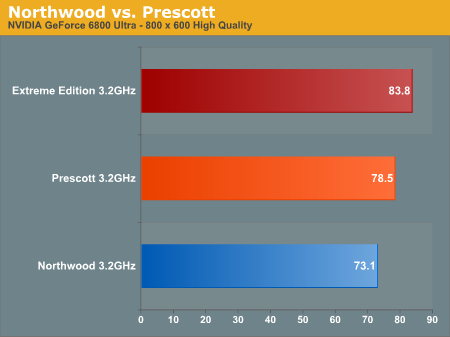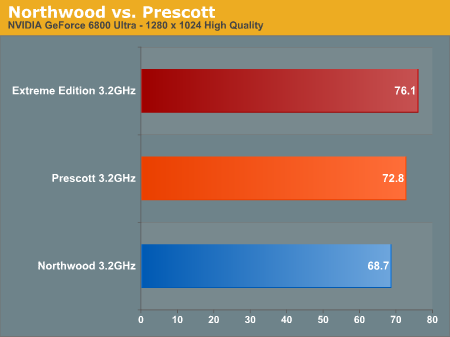Battle 1: Prescott vs. Northwood
The first battle of our Doom 3 CPU Comparison occurs between the two Pentium 4 cores: Prescott and Northwood.
You may remember from our review of Prescott that the new 90nm core was hard pressed to outperform its 130nm Northwood predecessor. Although Prescott featured twice the cache of Northwood, its longer pipeline and similar clock speeds held it back in most performance tests. However, Prescott does have one major advantage over Northwood - twice the L1-D and L2 cache. In other games the added cache has not been able to do much for Prescott, but let's see how that changes under Doom 3:

How the tables have turned - Prescott is actually faster than Northwood for a change, and at the same clock speed. A 7% performance advantage over the regular Pentium 4 3.2C is not too shabby for Prescott, but how can we be sure that the performance advantage is solely due to the cache size advantage? Look at the Extreme Edition.
The 3.2GHz Extreme Edition shares the same core as Northwood, but features a 2MB on-die L3 cache, and manages to outperform Northwood and Prescott by 15% and 7% respectively. These first benchmarks foreshadow what is soon to come and bring about a realization that Doom 3 is quite possibly the most memory/cache dependent game we've ever benchmarked.

The standings remain the same at higher resolutions, but as we've see the 6800 Ultra becomes mostly GPU limited at 1280x1024, reducing the impact of these processors. The Extreme Edition still manages to be 10% faster than Northwood, and Prescott continues to hold a lead over Northwood, just not as much at the higher resolution.
The last thing we wanted to look at in the Northwood vs. Prescott battle was how the two CPUs scaled - as we mentioned in our original Prescott review, we expected Prescott to do a better job scaling with clock speed than Northwood and we are beginning to see examples of that here in Doom 3:

Although it's ever-so-slight, Prescott's performance does seem to scale with clock speed better than Northwood.
The winner of this battle is clearly Prescott, we're sure Intel's happy that there's finally a situation where Northwood isn't in the limelight.










59 Comments
View All Comments
Anemone - Thursday, August 5, 2004 - link
I suggest you look at the low and average framerates for the EE @ 1600x1200. From memory I recall on HardOCP was that the AMD chips had a higher top end and a lower low end, making the average, whereas the P4's had high and low ends not so far away from their average.AMD64's fly, but at higher res's 1280 up to 1600, the difference is a few fps, and P4's seem to not fly as fast, but also not bottom out as bad in the super heavy scenes.
While I'm torn on the issue of which platform to go to, that is something I noticed.
DigitalDivine - Thursday, August 5, 2004 - link
Shinei, hardocp did not use apples to apples comparisons.dmxlite - Thursday, August 5, 2004 - link
"When tested at 1600 and real gameplay, Athlon 64 falls like a brick, as shown in the "Official Doom 3 hardware guide" at HardOCP."Yes, that must be the reason why in the conclusion they say "AMD came out ahead in DOOM 3 performance with the strongest CPU in our tests, the Athlon 64 FX-53 processor," and why they chose the stock FX to be in their [H]ard|OCP Ultimate DOOM 3 System and an overclocked A64 3000+ to be in their [H]ard|OCP Ultimate Enthusiast DOOM 3 System.
nlr_2000 - Wednesday, August 4, 2004 - link
It's called an on die memory controller ;)Staples - Wednesday, August 4, 2004 - link
Interesting how P4s were always top dog in Q3 but now with D3, it is the opposite.Shinei - Wednesday, August 4, 2004 - link
I don't know about you, T8000, but I can't complain about my (underclocked) 64MB Ti4200 and 3200+ XP combination. It drags in some areas (9fps as a low, 60 as a high, average gameplay flow is around 20; settings are 10x7 medium quality), but it's definitely playable in singleplayer, with very little mouse lag.So, for my Athlon XP to be performing fairly well with 2-year-old, underclocked hardware, I'm willing to say that HOCP is probably making things retarded for AMD by changing settings or something. I find it very hard to believe that the vastly superior Athlon 64s (compared to my Athlon XP) would falter so heavily in gameplay when my own processor does not.
T8000 - Wednesday, August 4, 2004 - link
I think you cannot say a CPU is better because it produces more frames in situations where it is hardly stressed, like lower resolutions and timedemos. Furthermore, I think most people want to play at an acceptable framerate with as much detail as possible, so testing a GF6800U only at 1280 and without playing the game, is not realistic.When tested at 1600 and real gameplay, Athlon 64 falls like a brick, as shown in the "Official Doom 3 hardware guide" at HardOCP. Only the overclocked Athlon FX could do slightly more then the P4EE at stock settings.
flexy - Wednesday, August 4, 2004 - link
>>>Whether the top-performing FX53 is worth the $811 price is up to you,
>>>
The answer is of course: NO
Neither is the PIV EE worth its price :)
flexy - Wednesday, August 4, 2004 - link
the most important info for me is that it's actually nonsense to wait for socket 939...or useless to spend more money for 1mb cache.So...socket 754 is even better/faster and cheaper. And the 512kb cache are plenty too for the A64.
This is very helpful info in regards to upgrading my system soon :)
Pumpkinierre - Wednesday, August 4, 2004 - link
Nice article Anand- strange set of results. I'd like to see the benchmark for a 2.4c at 3200MHz with same memory latency settings. If it is memory latency as the a64 results suggest then the Prescott should be lower or even beaten by N'wood. If it is L1 cache size then the EE result should be lower.